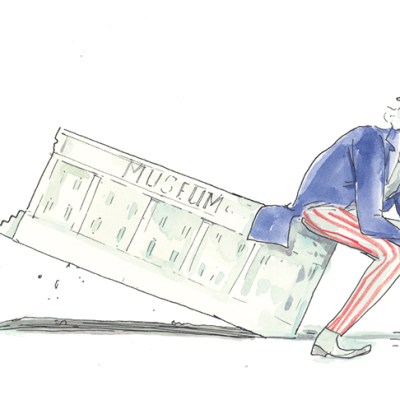Parliamentarians are set to move out of the Palace of Westminster temporarily as the building undergoes urgent repairs. But is it time they relocated for good?
Ed Vaizey
The Palace of Westminster has been the beating heart of British Parliament for around 500 years. The present structure came after a catastrophic fire in 1834, with a proposal from Charles Barry, aided by A.W.N. Pugin, winning a competition to redesign the building. But even this was a throwback to a bygone era.
Neoclassical architecture dominated in the 1800s – think, for example, of the Capitol and White House buildings in Washington, D.C., and the Bank of England in London, designed by John Soane. The American landmarks actually predate the Palace of Westminster by several decades; it’s even said that the style’s popularity in the US and its links to revolution were among the reasons it was rejected for our Houses of Parliament.
Barry’s winning proposal rewound the clock a few centuries, then, and adopted a gothic-inspired approach that embodied British conservative values, which have remained largely the same to this day. The Palace perpetuates the idea that Westminster is an ‘old boys’ club’, because that’s effectively what it was designed to be. Until recently equipped with its own shooting range, and with its swathes of male politicians commemorated in sculpture or other art forms, it is a building so aggressively grandiose that it’s aggressively unwelcoming.
The knock-on effect on inclusivity and diversity cannot be underestimated. While this is the most diverse Parliament yet, the proportion of female MPs is still only 32 per cent. The percentage of MPs who’ve received private education is also around four times that of the general population. The number of MPs from BAME backgrounds has improved but, as a proportion, it is still more than five per cent less than the national figure. For a Parliament aiming to represent and reflect the entire country this needs to improve. But when day-to-day politics take place in an antiquated, hyper-masculine fortress of a building, how can it? The politics of today are not the politics of yesterday – yet we remain bound to a building that begs to differ.
On the final day of the Blitz in 1941, the Commons Chamber was destroyed in an air raid, and MPs took temporary refuge in the House of Lords – where they debated the future design of the Commons. Many other European countries were starting to adopt a semicircular layout in their respective parliaments but, with the insistence of Winston Churchill, the new Commons reflected the old. Directly opposing benches remained and it was purposely built too small to fit every MP at once. Effective for rambunctious, tit-for-tat spectacle and 20-second videos for Twitter? Sure. But for cohesive, collaborative politics? Not so much.
We live in a particularly divided time politically and Parliament’s design compounds this. Plus, the site is increasingly unfit for purpose. MPs have (in many cases reluctantly) voted to leave the Palace for six years after 2025 so that urgent repair work can take place. It’s certainly expensive – the cost of the job is estimated to be around £3.5bn – but it is entirely necessary.
In my view it also provides the perfect opportunity to make the refurbished Palace a museum and permanently move Parliament to a new, fit-for-purpose, modern building.
Many Parliamentarians dismiss this idea outright due to what we’d potentially lose from a move: the customs, the tradition, the culture that is intertwined with political life in our current setting. But, for me, these are the exact reasons why we should take the leap. A heritage building fosters heritage politics.
The Palace of Westminster is one of the most iconic and important buildings in history – and that’s exactly where it should remain.
Ed Vaizey served as Minister for Culture, Communications and Creative Industries from 2010-16.
Michael Hall
Illustration by Graham Roumieu/Dutch Uncle

It is a fundamental principle of architectural conservation that the best purpose for a building is the one for which it was designed. Any work of architecture may be adaptable to new uses, but only if its design, and in particular its plan, are sufficiently flexible. To take major Victorian building types as an example, banks can successfully become bars or hotels, although usually at the cost of most of their original fittings. Churches are more difficult – they rarely make appealing houses – and nobody has yet suggested a satisfactory alternative use for law courts that does not involve gutting them. The suggestion that, if Parliament decides not to move back into it, the Palace of Westminster should become a museum at least recognises the fundamental fact that any other use would almost certainly involve massive alterations to a building designed for a purpose then unique in Britain.
One potential advantage of conversion into a museum might be that it could reduce the cost of refurbishment, currently estimated at around £3.5bn (on the understanding that the building is vacated for the duration of the works). Yet a large part of that cost is repair work, which will be necessary even if Parliament abandons its old home. Is the taxpayer likely to welcome the expenditure of billions to achieve a museum, especially as it would be on top of a huge bill for a new building?
In any case, the Palace of Westminster cannot be just a museum. Although there would be a public willing to pay to see the principal interiors – Westminster Hall, the two chambers, the lobby and the royal processional route – the majority of the building is no more than long, narrow corridors and small offices of little interest to a visitor. Such parts of the building would require a use of their own.
Ultimately, however, the idea that the Palace should become a museum is not based on any practical considerations: it is largely an expression of dissatisfaction not with the way the building functions but with what it represents. For its critics, its style is a fundamental issue. It is widely assumed that the Gothic Revival was inherently backward looking, and that therefore the Palace is a symbol of a reactionary, even feudal, political outlook. In fact, the Gothic Revival was multivalent in its meanings. The specification that the new Palace of Westminster was to be in the ‘national style’ – gothic or Elizabethan – was decided upon by a Tory government, but the Whigs expressed no serious disagreement with the appearance of a building that was to be the setting in which over the next half-century successive Liberal governments were to enact their reforms. From the 16th century onwards, gothic could often carry a radical message: far from embodying a feudal ideal, some new buildings in the style, such as the Gothic Temple at Stowe, symbolised the ancient liberties of the British people, free from monarchical or baronial tyranny. In addition, many 19th-century architects promoted the style not because of its historical resonances but because they thought it was more flexible than classicism in meeting the needs of the 19th century. The Palace of Westminster is a perfect exemplar: it was thoroughly modern in its construction and technologically advanced in its services.
The idea that the Gothic Revival is inherently conservative in its meanings has reinforced the idea that the Palace of Westminster projects a fantasy of the British constitution by emphasising its monarchical origins just at the time that the monarchy was losing the last vestiges of political power. As everyone has agreed, Charles Barry and A.W.N. Pugin were brilliantly successful in creating a setting for the ceremony of the State Opening of Parliament. However, much as some historians strain to see it as an invented tradition of Romantic medievalism, the State Opening is in fact ancient in almost every detail. Properly read, it – and the building that houses it – explains more honestly than is usually appreciated the grounds on which power in Britain rests. The executive may be chosen by the electorate but the power it exercises is supreme because derived from the ultimate authority of the Crown. That may seem an arcane matter, but as the example of Parliament struggling with the executive to take control of the Brexit negotiations demonstrates, it is a matter of daily and sometimes urgent political reality – very far from a museum, in fact.
Michael Hall is the author of George Frederick Bodley and the Later Gothic Revival in Britain and America (Yale).
From the April 2019 issue of Apollo. Preview and subscribe here.



